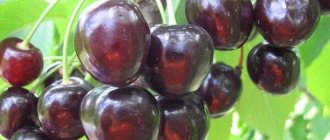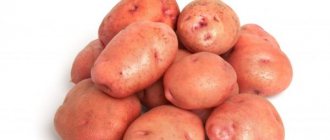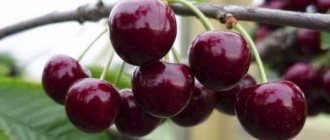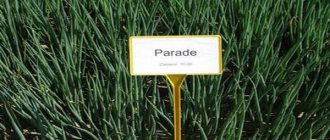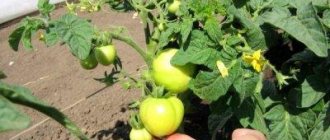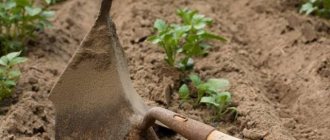Many cherry lovers prefer yellow-fruited hybrids. They have a delicate, unobtrusive taste and are ideal for dietary nutrition, especially for children. One of the most popular representatives, the Drogana yellow cherry variety, was bred a long time ago and came to us from Germany.
The names of the parent varieties have not been preserved. The author was the scientist Drogan, after whom the form was named. It is suitable for cultivation in central Russia, throughout Ukraine, Belarus and the Baltic countries. Over its long history, the variety has collected many positive reviews.
Drogan yellow cherry
Many cherry lovers prefer yellow-fruited hybrids.
They have a delicate, unobtrusive taste and are ideal for dietary nutrition, especially for children. One of the most popular representatives, the Drogana yellow cherry variety, was bred a long time ago and came to us from Germany. The names of the parent varieties have not been preserved. The author was the scientist Drogan, after whom the form was named. It is suitable for cultivation in central Russia, throughout Ukraine, Belarus and the Baltic countries. Over its long history, the variety has collected many positive reviews.
Description
The fruits are medium-sized or large, flat-round in shape. Different sources indicate the weight of drupes differently: from 4.5 grams to 8 grams. They are covered with thin light yellow skin. The pulp is also light, dense in consistency, with a lot of juice.
The taste is dessert, sweet. Compotes from Drogana are good for canning, but the fruits are not suitable for freezing. When defrosted, they do not retain their shape. Another disadvantage is poor transportability and detachability of the bone. But the high yield, more than 100 kilograms per tree, makes the variety stand out among its cherry “relatives.”
In industrial plantings, up to 10 t/ha can be harvested, and under particularly favorable circumstances - up to 20 t/ha. The fruits ripen simultaneously, in late June - early July.
The trees are quite tall, up to 5-6 meters. They grow especially quickly in the first years, when the crown has a pyramidal shape. Then it acquires wide-round outlines, and the growth rate slows down. The leaves are large, smooth, with pointed ends, and densely cover the branches. The flowers bloom relatively late and are therefore rarely damaged by return frosts. They are collected in small inflorescences of 2-3 pieces.
a brief description of
Pollinators and care
Yellow drogana definitely requires planting a pollinator nearby. Many varieties can act in this capacity, for example Aelita, Donchanka, Sestenka. The hybrid quickly begins to bear fruit; the first small harvest is usually harvested 3-4 years after planting the grafted seedling in a permanent place. Productive age is estimated at 25-30 years.
The winter hardiness of the wood is high, and that of the buds is average. The variety tolerates dry periods and windy weather well. It is also resistant to major fungal diseases that spoil the harvest and health of cherry trees.
Drogana yellow is propagated by grafting, the rootstock most often being Magaleb. Seedlings obtained in this way are famous for their unpretentiousness to soil, powerful root system and drought tolerance. However, trees need to be watered, especially newly planted ones. Subsequently, they move on to several waterings per season: in May, when the plants are actively increasing their vegetative mass, in June, when the fruits are filling, and in late autumn, to wet the soil before the onset of frost.
Planting cherries
Planting cherries requires sunny areas. It is advisable to think in advance about how to protect the trees from the cold wind. The plant prefers neutral or slightly acidic soils, so it is necessary to periodically lime the soil. At the same time, the plant’s need for calcium is also replenished, which cherries, like other stone fruits, need for normal development.
To plant cherries, you need to choose a place well lit by the sun.
Drogan yellow cherries do not tolerate stagnant moisture, so when planting, avoid low-lying areas and ensure a distance of at least 2 m from groundwater. The best soils for cherries are light sandy or sandy loam. When planting, you must remember that the Drogana yellow variety is self-sterile. To obtain a constant generous harvest of berries, pollinators must be nearby. The best for this role were recognized as Gedelfingenskaya, Napoleon Rose and Franz Joseph.
Nearby cherries also improve the quality of the fruit, although they are not technically pollinators.
For good fruiting, the Drogana yellow cherry tree needs pollinators.
Cherries are planted both in spring (before the buds swell) and in autumn (a month before the onset of cold weather). To do this, you need to dig planting holes at a distance of 4–5 m from each other. The crown of the Drogan cherry is yellow and spreading, and the roots, as a rule, are located in an area corresponding to the projection of the crown.
To plant cherries:
- Dig a hole measuring 80x80x70 cm.
- The top fertile layer is separated and mixed with compost or humus in equal proportions.
- Lime gravel is poured into the bottom of the planting hole to ensure drainage.
- A bag of dolomite flour is added to the gravel layer (to reduce the acidity of the environment and increase the calcium content in the soil).
- The fertile mixture is poured in, forming a mound. A peg is fixed on it, and a seedling is placed next to it, after which the roots are straightened, trying not to leave voids, and the soil is filled.
- Compact the soil around the tree, forming a watering hole. At the same time, make sure that the root collar rises slightly above the soil level.
- Tie the seedling to a peg.
- Water generously until water stops being absorbed.
- Mulch the tree trunk circle with dry peat or rotted sawdust.
- Carry out the initial pruning of the seedling (at a height of 60 cm), lubricating the cut with garden varnish.
Video: planting cherries
Spraying
Also, the garden must be sprayed prophylactically. There are now a lot of fungicidal and insecticidal preparations on sale. They can be mixed, making so-called “tank mixtures” to save effort and time. Trees are treated 4-5 times per season. Twice - in early spring and late autumn - spray the bare branches, trunk and soil in the circle around the trunk. The remaining treatments are carried out during the growing season, on the leaf apparatus.
To combat pathogens, they take, for example, Horus, Skor, and Aktara and Enzhio help against pests. Fertilizing is done according to the usual scheme, remembering that on poor sandy soils plants need nutrients more. Pruning is carried out in early spring.
Pros and cons of the Drogana Yellow cherry variety
The main advantages of cherries are considered to be medium-early periods of fruiting (4-5 years), a long period of productivity (up to 25 years), regular abundant yields (up to 150 kg per tree, up to 22 tons per 1 hectare), versatility in the use of berries.
When planting a garden, it is necessary to take into account that the variety is self-sterile. To ensure fruiting, several pollinators should be planted nearby. Cherries bloom and ripen quite late in the second half of June - early July.
Frost resistance of perennial wood, young branches and flower buds is average. Due to late development, generative organs rarely freeze under early frosts in spring. The variety is resistant to drought, as well as the most common fungal diseases.
Disadvantages include poor transportability of fruits, their cracking in rainy weather, and unsuitability for freezing. In addition, Drogan cherries suffer from fruit rot with moderate frequency and are highly vulnerable to the cherry fly.
Growing Drogana Yellow Cherries
When planting a garden, it is necessary to select several mutually pollinating varieties. Drogan's cherry is not self-fertile, therefore, to increase productivity, 2-3 suitable pollinators are planted nearby, coinciding with it in terms of flowering dates (Bryanochka, Revna, Bagration, Franz Joseph). Trees grow quickly. To ensure good nutrition of the root system, the optimal interval between seedlings should be 5-6 m.
When to plant?
It is recommended to plant young trees at the stage of slowing down development processes. For warm regions where there is a risk of rapid onset of hot weather, the best time for planting is September - late October. In autumn, the soil is well moistened; additional watering is not required. Over the winter, the seedlings will be able to grow young roots, therefore, they will retain strength for crown development and flowering.
In the fall, you can purchase seedlings at a discount, see which cherries bear fruit and compare different varieties.
If you did not have time to plant a seedling on the site in the fall, it is sprinkled with soil before the end of winter, placing it at a slope of 45 degrees. In the northern regions of Russia with a cool climate, it is better to plant Drogan cherries in the spring.
Choosing a place and soil for cherries
For planting this variety, areas protected from the wind with light, moist soils are most suitable. In the first year, the root system grows quickly; deep root feeding without damaging the roots cannot be done. Therefore, you should take a responsible approach to preparing a permanent place.
Planting holes are dug 80x100cm in size. Having previously mixed 3 buckets of humus or organic matter with the top fertile soil, 2 kg of ammonium sulfate, 3 kg of superphosphate, 0.5 kg of potassium fertilizers, fill the hole to a third of the depth in the form of a mound.
Planting Drogana Yellow cherries
Damaged roots are removed from seedlings (preferably annuals), pruned to healthy tissue. The tree is placed on an earthen mound, the roots are straightened, and covered tightly with prepared soil. The root collar is placed 3 cm from the soil. Water well - 10 liters per tree. Thoroughly mulch the soil with peat or humus.
How to plant cherries
Planting and caring for Drogan yellow cherries have their own characteristics. Usually, cherries are planted in spring in prepared holes. If seedlings are purchased in the summer, they are planted two weeks later, having previously prepared the soil.
A two-year-old seedling is placed in a hole 70 cm wide and 70 cm deep. If the soil is not heavy, these figures can be reduced by 10-15 cm. The removed top layer of soil is removed to the side; it will be needed in the spring for backfilling.
Chopped herbs and leaves are placed in the planting hole, and a solution of manure or an infusion of green manure is poured. Fertilize with superphosphate, potassium sulfate, mix well.
In spring, a bucket of humus and peat is added to the top soil. Drive in a peg, fill it with soil and water it well. After a couple of hours, you can plant the cherries, straightening the root structure. The root collar should rise 4-5 cm above the ground.
After falling asleep, the seedling needs to be tied with a rope and watered. After some time, the soil will settle and the root collar will drop to ground level. The tree trunk circle is covered with peat and grass mulch.
In the central regions of Russia, the soil is cold and infertile, so a common method among gardeners is to plant cherries in flower beds 2-2.5 meters wide, raised 60 cm above ground level. It is also necessary to prepare such flower beds in the fall. To do this, loosen the top layer, make sand and gravel drainage (10 cm), then add a layer of compost with potash and superphosphate fertilizers (30 cm), as well as fertile soil.
In the spring, a hole is made in the flowerbed for planting, a stake is placed, cherries are planted, covered with soil, tied and watered. Mulch is placed on the surface. The flowerbed needs high-quality mulch and abundant watering.
Further care of the variety
The development and fruiting of cherries largely depends on care. Trees need to be provided with regular watering, the application of suitable fertilizers, treatment for diseases and proper timely pruning.
How to water and fertilize correctly?
Moisten the soil around the yellow Drogan cherry according to the standard scheme. In the summer, taking into account the precipitation, several additional waterings of the tree are carried out. Each time the soil is loosened and mulched with humus. In the fall, before the onset of frost, cherries are thoroughly watered to completely saturate the soil with moisture.
If it was not possible to do this on time, it is necessary to water in the spring before flowering begins.
In the first year after planting, the soil in the area with seedlings is regularly loosened and weeds are completely destroyed. This ensures maximum moisture retention. Before the onset of cold weather, cherries require additional watering before loosening the soil. From the second year, the soil is cultivated within a radius of 50 cm, moving away from the trunk another 50 cm every year.
The amount of preparations depends on the characteristics of the soil. It is preferable to use liquid fertilizers; it is easier to plant them to a depth of at least 20 cm. Dry mineral fertilizers must be dissolved before application. The soil should be watered with nutrient solutions in the growth zone of young roots, which intensively absorb liquid.
The yield can be improved by sowing green manure that accumulates nitrogen. Any plants from the legume family, as well as honey plants, are suitable. They are sown in the second half of the growth and development phase of yellow cherries. In autumn, the resulting grass cover is mowed and used as mulch.
Care
The tree needs to be watered 3-4 times throughout the entire season. Water is especially necessary for the crop during flowering and fruit ripening. 5-10 buckets of water are poured under one tree. It is worth noting that watering stops 20 days before harvesting.
In addition, it is necessary to constantly loosen the soil to remove weeds. Stagnation of water in the soil poses a huge danger to cherries. So after rain or watering, it is also important to loosen to a depth of 10 centimeters.
It is also recommended to carry out pruning, since it determines the yield of the crop, the quality of the fruit, and reduces the risk of disease development. Over the course of 5-6 years after planting, the plant forms a tiered, sparse crown. The central conductor and shoot are reduced by a third of the length. Every year a new tier is formed. Pruning activities are carried out in spring or autumn, when the movement of sap slows down.
Description and characteristics of the variety
We will tell you in more detail what this cherry looks like, what its pollinators are, its yield and frost resistance, and we will also describe the main advantages and disadvantages of the variety.
Appearance of cherries
The tree of this variety reaches a height of 5-6 m and has dense foliage. In the first years it has a pyramidal crown, later it acquires a rounded shape. The leaves are large, have pointed ends and a smooth structure.
The inflorescences are small, each containing 2-3 flowers. The fruits are medium or large in size, flat-round in shape and light yellow skin. The pulp is juicy, sweet, light in color and dense in consistency. The weight of the fruit ranges from 4.5 to 8 g.
Pollinators and productivity
Drogana Yellow is self-sterile, so it will require pollinators to bear fruit. For pollination, it is necessary to have at least one variety of red, black or yellow cherry on the site, which has the same flowering period as Drogana Zhelta.
Recommended pollinators for this cherry are:
- Revna . It has good productivity. The fruits of this variety have a burgundy color and dense texture, weighing on average 4.7 g;
- Bagration . The fruits are light yellow with a pink blush, the flesh is sweet and juicy. The weight of cherries ranges from 7.5 to 8 g;
- Bryanochka . Trees of medium height with a sparse crown. The fruits are sweet, dark red in color. The variety has high frost resistance and average resistance to diseases;
- Franz Joseph . Brings a good harvest. The fruits are yellow with a pink blush, the flesh is juicy and sweet. The fruits weigh on average 6-7 g.
Drogana Yellow begins to bear fruit 4-5 years after planting. The variety is distinguished by good yield, which is 50–70 kg per tree; under favorable conditions, this figure can grow up to 100 kg of cherries.
Frost resistance
Drogana Yellow is frost-resistant, can tolerate temperatures down to -35°C. Flowering is relatively late, so the flowers are not killed by return frosts.
Advantages and disadvantages of the variety
- Among the positive qualities of Drogana Yellow we can note:
- good taste of fruits;
- adaptability to different climatic conditions;
- undemanding to the composition of the soil;
- good drought resistance.
- Despite the large number of advantages of the variety, it is necessary to note the following disadvantages:
- poor shelf life of fruits and transportability;
- the need for pollinator trees.
Advantages and disadvantages of the variety
The characteristics of the Drogana yellow cherry make it possible to highlight the pros and cons of the variety. The advantages include:
- high adaptation to any climatic conditions;
- winter hardiness;
- resistance to short-term drought;
- undemanding to soil;
- excellent taste of the fruit.
Minuses:
- poor transportability;
- susceptibility to attack by cherry flies and fruit rot.
Disease and pest control
The most common diseases of Drogana Yellow are:
- Polypore . A fungal disease that affects the trunk of a tree. Cherries affected by the disease weaken and die. To prevent the disease, you need to treat the trunk with a solution of lime.
- Gray rot . Young shoots are especially susceptible to it. As a result of the disease, the fruits rot and must be destroyed immediately. To save a tree from this disease, you need to treat it with a solution of copper sulfate and nitrophen.
The main pests that affect Drogana Yellow:
- Cherry fly . She lays eggs in unripe fruits, from which larvae hatch and destroy the pulp. It is necessary to combat these pests in the spring by hanging yellow traps with sticky glue.
Tube gun . These insects feed on buds, buds, flowers and fruits. To combat the tubeworm, it is necessary to treat it after flowering with Aktara, and after 2 weeks with one of the pyrethroid preparations. To reduce the density of the pest population, you need to periodically dig up the soil, shake off the trees and destroy the beetles.
Diseases and pests
Sometimes cherries suffer from attacks from various pests or diseases. But her immunity is quite good. Let's consider the main problems relevant to the variety.
tinder
The tinder fungus loves to settle on all deciduous trees, and cherries are no exception. It usually attacks weak dead plants or stumps. Due to its activity, core rot, light yellow or white rot occurs, and the wood becomes very brittle. Trees that are weather-scarred, have wind-broken branches, are sun-scorched, or are cracked by cold are especially susceptible.
If the fungus appeared on a branch, then there is a possibility that the infection did not have time to affect the entire plant. In such a situation, it is advisable to remove the branch right next to the trunk. Based on the state of the cut, conclusions can be drawn about the state of the culture. If the wood is bright and moist and hard, then the danger has passed. But if it is dark and soft, then the cherry cannot be saved. It is very important to carefully process the cut at the location of the mushroom.
You can also remove the body of the fungus and then treat the plant with a disinfectant composition - a 3% solution of copper sulfate. For prevention, it is recommended to treat the trunk with dissolved lime.
Fruit rot
The disease spreads very quickly throughout the entire area and causes rotting of almost the entire crop. First, the shoots and branches of the plant become brown, wither, and look as if they have been burned. Old branches become covered with cracks and gum, and over time they die.
In the summer, the disease actively progresses and attacks the fruits. They gradually change color to gray and begin to mummify. Some of them fall off, while others may hang until next spring.
To fight, you should follow these recommendations:
- Cut and remove all damaged shoots, inflorescences and branches. Remove inflorescences 20 days after flowering, including 10 centimeters of healthy tissue. Systematically dispose of mummified fruits.
- Spray the trees with Bordeaux mixture and HOM and Abiga-Pik preparations.
- Store only whole and healthy fruits without damage.
cherry fly
The cherry fly often attacks cherries. Due to its activity, larvae appear in the fruits, while they themselves become dull and soft, rot and fall off. Insecticides should be used for control. For prevention, you should constantly loosen the soil around the trunk and use glue traps. The harvest must be collected as soon as possible, and all carrion must be disposed of.
Birds
It's no secret that birds love to eat cherries. To drive them away from your site, it is enough to use scarecrows, rattles, and loud sounds. Additionally, you can cover the trunk with a fishing net or one with very small meshes. Spray the plant itself with red pepper solution. You can also use repellent gels.

